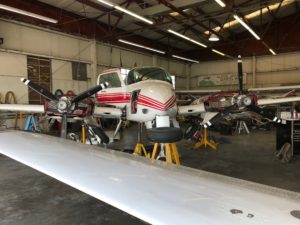Podcast: Play in new window | Download
When you check the cylinder compressions on an airplane engine, it’s important to “Hold That Prop!” And on a twin engine airplane with 6 cylinder Continental engines and 3 bladed props, the prop blades will be positioned in one of two ways, depending on how the prop is installed on the engine.
Here’s a Cessna 310 showing the two possible positions that can typically happen after shutdown. Listen to today’s episode to find out what was discovered during the compression test and what we did about it.
Also, we talk about some other tips and ideas for compression testing in general.
Compression testing can be a dangerous operation, so here are some tips to consider:
- Compression testing is best done with two people, one to hold the prop and one to hold the gauges.
- The person holding the prop is in charge.
- Never attach the air hose to the cylinder unless someone is firmly holding the prop.
- Establish a routine for compression testing to make it safer and more efficient.



Dean,
Regarding Compression Testing Safety: You mentioned, @ 22:00 of podcast 93, that you had once been hit by a prop. I recently had the privilege of observing a compression test on a G-480. And, I was impressed by the physical exertion exhibited by the fellow tasked with holding the propeller. He was kind of a crusty old cuss so I did not make this suggestion to him: Have you ever heard of “roping the cylinder”. This involves inserting rope into any cylinder approaching top dead center. Done correctly, this would facilitate the compression test and prevent a prop from “escaping” the clutch of it’s master and causing injury.
“Roping the cylinder” is a technique routinely employed during 3-engine ferry of 4-engine reciprocating powered aircraft to secure inoperative piston engines. The rotation of which could cause the propeller to come out of it’s feathered position, and run away.
I greatly enjoy your podcasts and thank you for making your wealth of knowledge available to our aviation community.
Britt,
Roping the cylinder is a very interesting idea for ferrying a 4 engine aircraft… makes sense to keep the inop engine from turning during flight.
As far as “roping the cylinder” during compression testing, I’ve never heard of that. During compression testing, we need the cylinder at top center on the compression stroke. When it’s perfectly at top center, it usually does not take a lot of effort to keep the prop from turning. But as we rotate the prop back and forth on either side of top center, that’s when it takes a lot of pressure, and deserves much caution. If we put a rope in the cylinder, it would not let us position the piston at top center, so I don’t think that would work. The bottom line is we always need to use great caution while performing a compression test. Thanks for your post here… it’s a very interesting idea to think about!